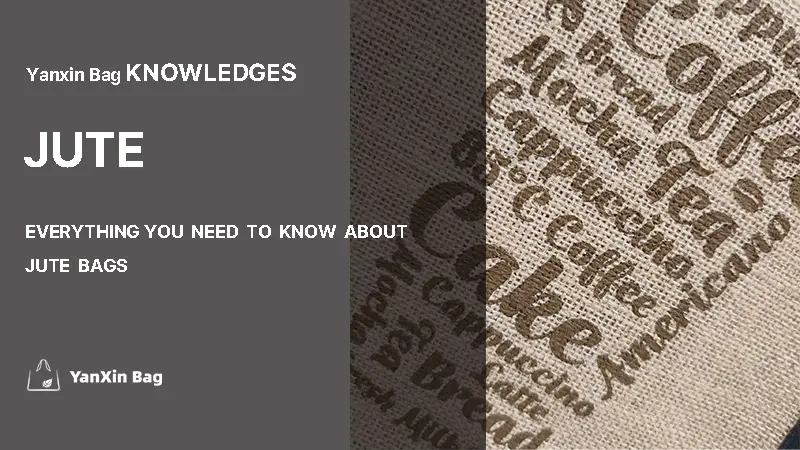
In today’s world, where environmental awareness is on the rise, jute bags, as a sustainable and eco-friendly alternative, are gradually replacing traditional plastic bags. As global concerns about plastic pollution deepen, more and more consumers and businesses are turning to jute bags, not only to reduce plastic waste but also to embrace a greener lifestyle. Jute bags are not only highly functional and durable, but they also add a unique style and eco-friendly value to daily shopping, gift packaging, and brand marketing. This article will delve into the history, uses, advantages, and disadvantages of jute bags, as well as the customization process, helping you gain a comprehensive understanding of this eco-friendly product and explore how to integrate it into your daily life and business practices.
A jute bag is a bag made from jute (also known as burlap), a natural plant fiber known for its strength, durability, and eco-friendliness. Jute bags are commonly used for shopping, packaging, and gift bags. They typically have a natural rough texture and are widely used in sustainable lifestyles. Due to their environmental benefits, jute bags are often chosen as a more eco-friendly alternative to plastic bags.
The history of jute bags can be traced back thousands of years. Jute, a natural plant fiber, was first widely used in regions like India and Bangladesh. Initially, jute was used to make ropes and textiles, primarily for packaging and transportation. In the 19th century, with the rise of industrialization, jute bags became an important global trade tool, especially for transporting goods like grains and coffee. In the 20th century, as plastic bags became more popular, the use of jute bags declined. However, with the rise of environmental awareness, jute bags have experienced a resurgence, especially as a sustainable, eco-friendly alternative. In the 21st century, jute bags are not only popular for shopping but have also become fashionable accessories and popular choices for corporate promotions. As global attention on environmental issues continues to grow, the applications of jute bags continue to expand, making them a symbol of a green lifestyle.
Jute is a biodegradable material. True
Jute is a natural fiber that is biodegradable, making it an environmentally friendly option.
Jute is not affected by sunlight. False
Jute is sensitive to prolonged exposure to sunlight, which can cause discoloration and weaken the fibers over time.
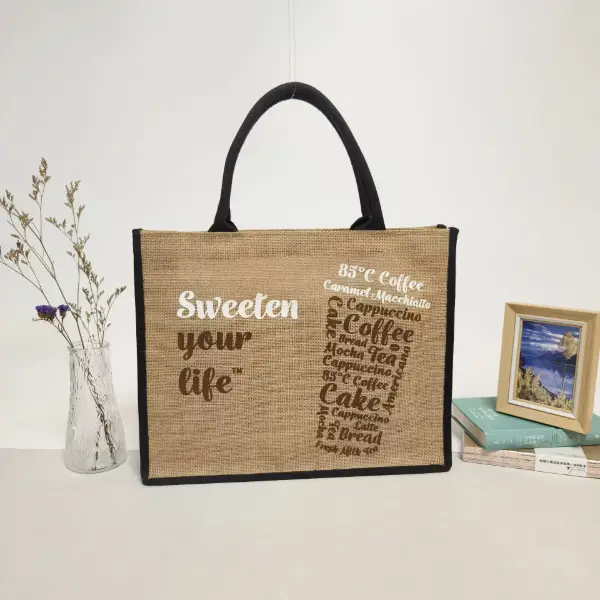
Considering jute bags? Read our detailed analysis on the Pros and Cons of Jute Bags to evaluate if they’re the right fit for your needs.
Jute has a natural coarse texture, making it suitable for packaging. True
Jute’s coarse texture makes it ideal for packaging materials, especially for heavy-duty bags and sacks.
Jute is stronger than synthetic fibers like nylon. False
While jute is strong, it is not as strong or durable as synthetic fibers like nylon, which are designed to handle more extreme conditions.
If these printing methods seem complicated, don’t worry. The easiest approach is to provide your design to customer service for a quote. Based on your design, the customer service team will recommend the appropriate printing method1 and provide multiple price options. You just need to choose the option that suits you.
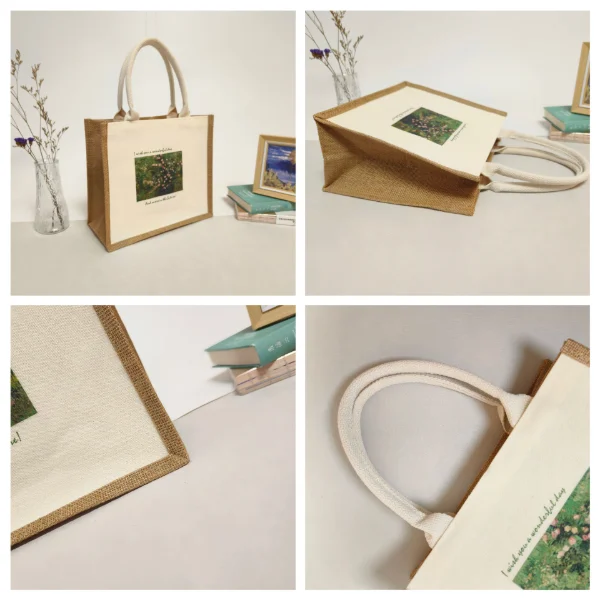
Customizing jute bags is a multi-step process that involves design, material selection, and printing techniques. Here are the main steps and considerations for customizing jute bags:
Considerations for the Bag Itself:
Consider the intended use of the jute bags, such as for shopping, promotions, exhibitions, corporate events, giveaways, gifts, etc. Defining the purpose helps narrow down the range of options.
Establishing a clear budget framework will help you make better decisions, including your overall procurement budget and the required quantity. After analyzing the total budget, you can calculate the cost per bag and find suitable options.
Choose the bag size based on the target customer group’s needs or the size of your products.
You can also offer various size options to meet the needs of a broader customer base.
If you are unsure about the size, you can consult with suppliers. They typically provide past case studies to help you select the right size. This ensures that the bag meets practical usage requirements and avoids issues with bags being too large or too small.
S Size: 26.5W * 20H * 9G CM, suitable for small items, gift bags
M Size: 36.5W * 30H * 17G CM, suitable for daily shopping, promotional activities.
L Size: 45W * 35H * 14G CM, suitable for packaging books, documents, and other large items.

Uncoated Jute Bags: These are made from pure natural jute fiber, offering good breathability. They are ideal for storing items that require ventilation, such as food or clothing. Without additional coatings, they are more eco-friendly but lack waterproofing properties.
Coated Jute Bags: These bags are coated with a layer of waterproof PE, enhancing durability and water resistance. Common models include 45D and 50D, which are suitable for shopping bags, promotional bags, and other uses requiring extra protection. Coated jute bags prevent water from seeping through and make the bags more durable, making them suitable for use in humid environments.
Here are several common jute bag styles:
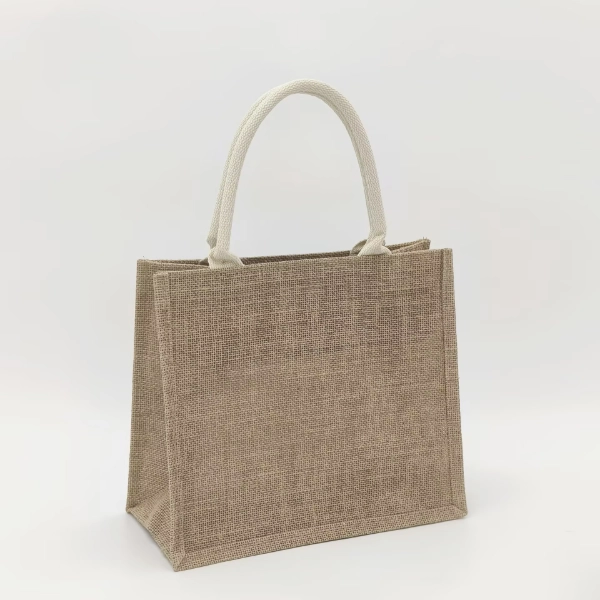
This is the most classic and versatile jute bag design, featuring both a flat bottom and gusseted sides that allow the bag to expand and hold more items. It is made from a single color of raw jute fabric, offering a clean, natural look that suits various branding needs.
In addition to the basic bottom and side design, this bag features webbing edging, making it more stylish and durable. The color of the edging can match the handle color to enhance the overall look.


This style usually features an additional large pocket on the front, making it convenient for storing items that need to be accessed quickly. It is ideal as a stylish shopping bag or promotional bag.
This design combines jute and canvas materials, adding a modern and fashionable touch. The canvas portion adds structure and durability to the bag while still maintaining the natural style of the jute.


This style enhances visual appeal by combining natural jute fabric with bold contrasting colors on the sides and bottom. The color-block design makes the bag more eye-catching and modern, appealing especially to younger audiences or lifestyle-focused brands.
This design combines jute and non-woven fabric, enhancing the bag’s fashion sense. The addition of non-woven fabric also helps reduce costs and provides a more vibrant color, which is often more aesthetically pleasing than dyed jute.
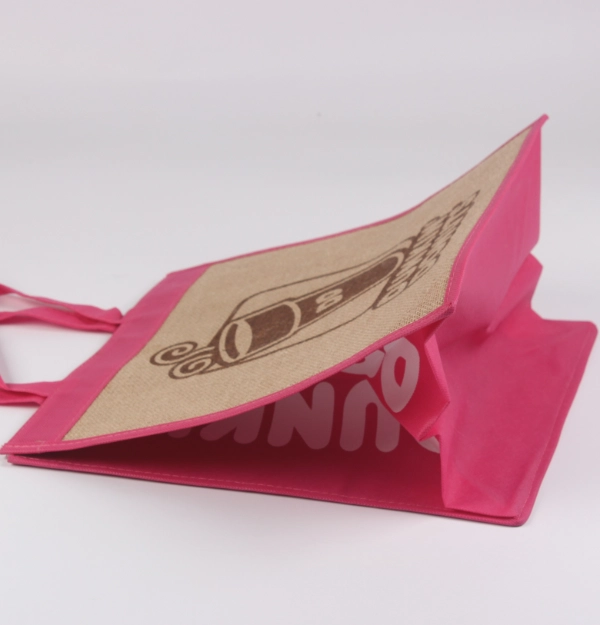

Specially designed to package bottled items such as wine, milk bottles, or beverage bottles. Jute bottle bags effectively protect the bottle while adding a high-end feel to the product, often used for premium packaging.
This jute bag features a bottom gusset but no side expansion, giving it a slim and minimalist silhouette. Its compact structure is ideal for lightweight use, such as carrying documents, brochures, cosmetics, or other small daily essentials. The bag maintains a neat, rectangular shape when filled and is often chosen for events or packaging scenarios where space-saving and simplicity are important.

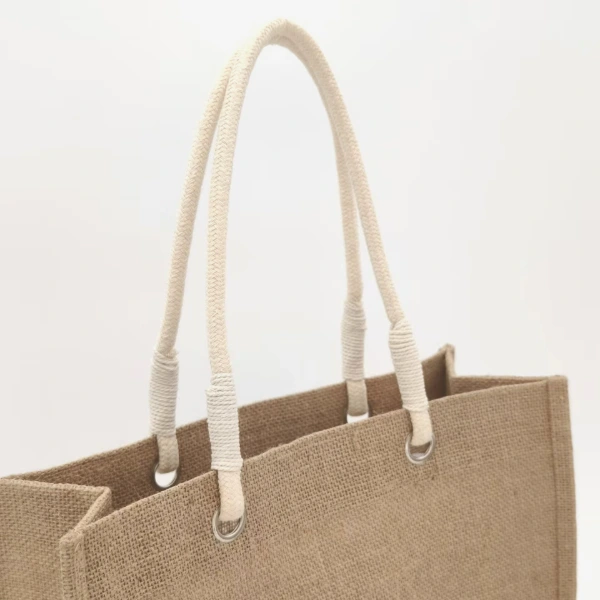
This jute bag features metal eyelets at the handle connection, adding both stability and a fashionable touch. It is perfect for younger consumers or for brand marketing.
This style of jute bag has no additional coating, and its internal seams are designed to be simpler. Without a coating, the bag is more flexible and breathable.
Bags in styles 1-9 generally have a waterproof PE coating2 inside, which makes the bag more structured and waterproof.
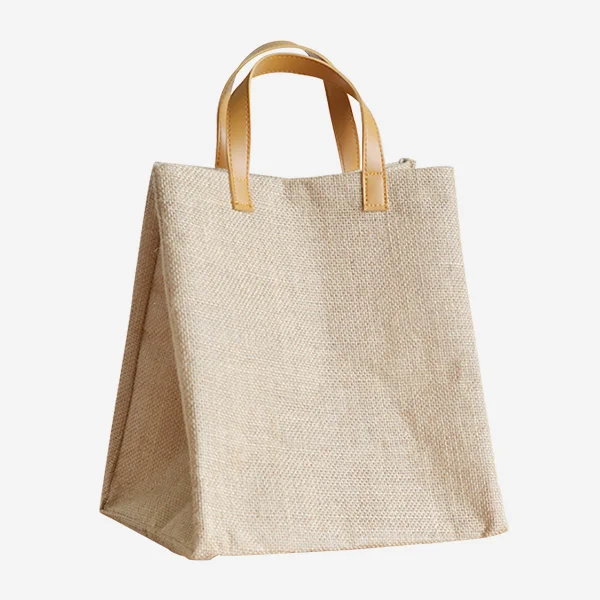
Jute plants require minimal use of fertilizers and pesticides. True
Jute plants are hardy and require little to no fertilizers or pesticides compared to other crops like cotton, making them more sustainable.
Jute is a perfect material for high-fashion clothing. False
Jute fibers can be rough on the skin and are not commonly used in high-fashion clothing unless blended with softer materials.
Jute Material Handles:
These handles are made from the same jute material as the bag itself, offering a coordinated and natural look, perfect for those who prefer eco-friendly and natural styles.
Cotton Rope Handles:
These handles are made from soft cotton rope, suitable for making fashionable, vintage-style jute bags. They are comfortable and offer a unique texture.
Eyelet Handles:
Metal eyelets at the handle connection not only strengthen the handle but also add to the overall design, making the bag more stylish.
PU Leather Handles:
These handles use PU leather, adding a modern and high-end touch to the jute bag, making them ideal for premium custom bags or fashion brand promotions.
Webbing Handles:
These handles come in various colors and can help reduce costs while providing durability and comfort.
Webbing Handles with Cotton Rope Inside:
This design has cotton rope embedded inside the webbing, adding comfort and a fashionable look, suitable for daily use.

If you are working with a design company, you can provide your logo, promotional slogans, graphics, or other design elements to be printed on the template of the bag, which will save time in communication with the supplier. If you do not have a design company or department and only have a logo, that’s perfectly fine. Some experienced suppliers can offer simple design services for you. However, if your design is more complex and time-consuming, additional design fees may apply. Here are a few design suggestions:
Design patterns should reflect your brand’s priorities and image. A well-designed custom bag increases the likelihood of customer use, which in turn enhances brand exposure. The design should be attractive and align with the brand spirit, encouraging customers to display and use it.
Designs can convey brand personality3 through logos, motivational quotes, brand slogans, or illustrations. Simple and direct designs are the most effective while ensuring visual appeal. For custom backpacks, you can place contact information or a website on the back of the bag, making full use of both sides of the design space.
Custom bags offer significant flexibility in design, allowing design placement and size adjustments based on bag style. Different styles (e.g., custom luggage bags or shopping bags) may have different design areas, so flexibility is key.
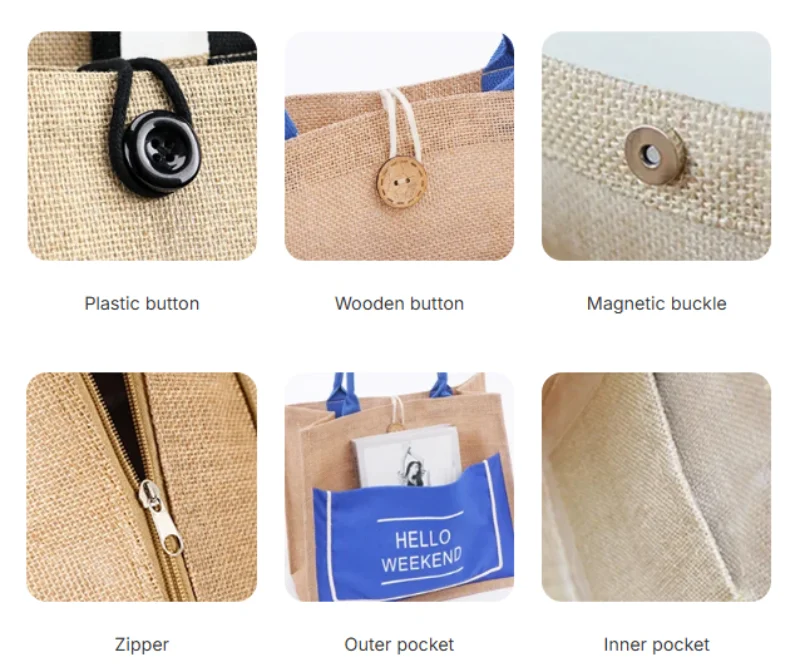
Jute can be used to make biodegradable pots for plants. True
Jute's biodegradability makes it an ideal material for creating eco-friendly, biodegradable plant pots.
Jute is completely resistant to water damage. False
Jute loses its strength when wet and is not naturally resistant to water damage.
Jute bags, as an eco-friendly, practical, and stylish product, are increasingly becoming a must-have item in daily life. From shopping bags to gift bags, from custom promotional bags to high-end brand packaging, the applications of jute bags are vast and cater to a variety of needs. Whether it’s their natural materials, reusability, or unique customization options, jute bags promote a greener lifestyle while providing great convenience and diversity.
By selecting the right size, material, style, and accessories, jute bags can not only enhance brand image but also help reduce dependence on plastic bags, contributing to the environmental cause. In everyday life, each of us can take part in the global trend of sustainability by choosing jute bags and taking a step toward a greener future.
If you have any questions or need assistance in selecting the right jute bag, feel free to contact YanxinBag. We’re here to help you choose the perfect bag and ensure smooth packaging for your business.
Learn how jute bags are made in our complete eco-friendly guide: How Jute Bags Are Made
This guide uncovers the science, materials, usage tips, and niche innovations behind jute bags. To explore specific topics further, we’ve curated our most valuable supporting articles below.
Get a free quote and expert consultation today. Let's bring your brand vision to life.
Learn about jute and its environmental benefits on the Wikipedia Jute article.
Find a comprehensive guide on jute fabric, including types and uses at Treasurie.
Learn about the properties, advantages, and uses of jute fromJute Guru
1 Exploring various printing methods will give you insights into which one best fits your design needs and budget.
2 Learn how waterproof PE coating improves the durability and functionality of bags, making them suitable for various conditions.
3 Understanding how to convey brand personality through design can enhance your branding strategy and customer connection.
Answer: With proper care, jute bags can last up to 4 years or more. They are highly durable but should be kept dry to prevent mold and mildew.
Answer: Jute bags are not naturally water-resistant. They absorb moisture, so it’s essential to keep them dry to avoid mold and mildew growth.
Answer: To keep jute bags in good condition, store them in a dry, cool place, and avoid folding them to prevent wrinkles and maintain their shape.
Answer: Yes, jute bags are versatile and can be used for a wide range of products, from groceries to gifts and promotional items. However, for extremely delicate or small items, it’s better to use bags with additional features like liners or more secure closures.
Answer: To extend the life of your jute bags, avoid machine washing and high heat exposure. Hand wash or spot clean them using mild detergent and air dry in a shaded area. Storing them in a dry, cool space will also prevent mold and deterioration.
Answer: Yes, jute bags are highly sustainable. They are biodegradable, meaning they break down quickly in the environment compared to plastic bags. They are also made from a renewable resource, and their reusable nature reduces the need for single-use plastics.
Answer: Absolutely! Jute bags are highly customizable. Businesses can add logos, slogans, and custom designs to create promotional bags. Whether for corporate events, giveaways, or retail packaging, jute bags are a perfect eco-friendly branding tool.
Answer: Yes, jute bags come in various sizes and styles, from small gift bags to larger shopping or promotional bags. Some jute bags have additional features like side pockets, zippers, or special coatings for added durability and functionality.
Answer: Yes, jute bags have become increasingly fashionable. With various designs, including modern prints, contrasting colors, and custom branding, they are popular for use as everyday fashion accessories, handbags, and even stylish eco-friendly totes.
Answer: Yes, jute bags are highly durable and can carry heavy loads due to the strong fibers of jute. However, for extremely heavy items, you may want to look for jute bags with reinforced stitching or additional coatings for extra support.
Answer: Jute bags can be creatively repurposed for many uses. They can be turned into home décor items like table runners, cushion covers, or plant hangers. You can also use them for storage, gardening, or even crafting projects, making them a perfect item for upcycling.

Order or no-order we are Always here to help you!
We will contact you within 1 working day, please pay attention to the email with the suffix “@yanxinbag.com”.
Order or no-order we are Always here to help you!
We will contact you within 1 working day, please pay attention to the email with the suffix “@yanxinbag.com”.